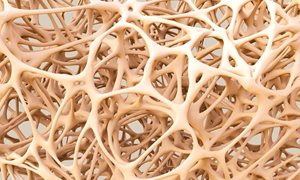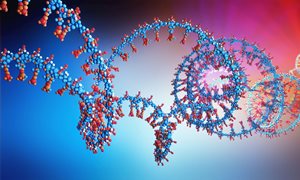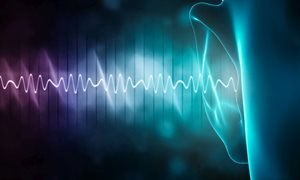
Researchers from Radboudumc and Eindhoven University of Technology have interwoven various bone cells into an 'organoid' that can independently make new, hard bone tissue. It’s the most complete 3D model of bone formation to date. The 3D model allows for the study of the key biochemical processes in unprecedented detail and could help in cracking the many mysteries surrounding bone formation. Moreover, the lab-grown bone is particularly suitable for testing and designing new treatments for bone diseases such as osteoporosis or osteogenesis imperfecta.
Imagine using stem cells from your bone marrow to grow a new piece of your bone tissue in the lab, after which medical doctors explore how certain drugs affect your bone tissue. In this way, a tailor-made treatment plan could be made for you, and potentially for everyone. Welcome to the world of personalized medicine.
This vision of drug development is no longer science fiction now that researchers from Eindhoven University of Technology and Radboud university medical center have actually realized the first part: growing a lifelike piece of bone tissue from human stem cells. It is the first organoid of bone, a simplified version of the original bone, and the researchers report about it today in the journal Advanced Functional Materials.
Coherent picture
"With this, we present, for the first time, the full picture of early-stage bone formation," says Sandra Hofmann, associate professor in Bioengineering Bone from TU/e. And this is of great importance, particularly as the process by which bones form is still largely a mystery. Bone is a very complex material in which, on the one hand, countless cells and processes interact and, on the other hand, an ingenious matrix of collagen and mineral is built up to provide material strength. Much is known about the individual components, but a coherent picture has been lacking until now.
Three types of cells play the main role in bone formation: osteoblasts (which build bone tissue), osteoclasts (which take bone away) and osteocytes (which regulate the building and breaking down of bone). "Most studies so far have focused on one of these types of cells, but that is not a good representation of the real tissue," says Hofmann. "We present here a piece of woven bone (early-stage bone) that developed from stem cells and contains two types of bone cells: osteoblasts and osteocytes. We now see that we can make lifelike bone exclusively with these two cell types."
Getting wiser from molecular poking
"And perhaps more importantly, our system behaves just like early-stage bone ", says Anat Akiva, assistant professor Cell Biology at Radboudumc. "We show that both types of cells produce the proteins that the cells need for their functionality, and we show with the greatest detail that the matrix actually is the bone matrix we see in real tissue.”
The fact that a simplified representation of the formation of bone at the molecular level is now possible offers unprecedented possibilities, according to the researchers. "A bone consists of 99% collagen and minerals, but there is also another 1% of proteins that are essential for successful bone formation," explains professor Nico Sommerdijk from Radboudumc. "So what’s the role of these proteins? How do they support bone formation? Never before have we been able to look at the milestones of this process at a molecular level."
And with that, they immediately have a great starting point from which to investigate the cause of genetic bone diseases such as “brittle bone disease” and their possible treatments for instance in our Electron Microscopy Center. "Remember that the origin of many diseases is at the molecular level - and so is the treatment," says Akiva. "In fact, we now have a simple system in a reliable environment where we can poke around and see what happens."
Publication
Paper in Advanced Functional Materials: An Organoid for Woven Bone - Anat Akiva, Johanna Melke, Sana Ansari, Nalan Liv, Robin van der Meijden, Merijn van Erp, Feihu Zhao, Merula Stout, Wouter H. Nijhuis, Cilia de Heus, Claudia Muñiz Ortera, Job Fermie, Judith Klumperman, Keita Ito, Nico Sommerdijk, Sandra Hofmann
-
Want to know more about these subjects? Click on the buttons below for more news.
Related news items

The future of laboratory animal research More attention to living conditions of laboratory animals
16 May 2022 On May 9, a meeting took place at the Radboudumc as a result of the launch of the Dutch Transparency Agreement on Animal Testing. The Radboudumc is one of the twenty signatories and has thus committed itself to openly and transparently communicate its vision and policy with regard to animal testing. go to page
Hidden genetic defects contain real risks for serious diseases Genome test for consanguineous couples makes sense
19 March 2021 For the first time researchers from Hebrew University of Jerusalem, Radboudumc, Maastricht UMC+ and international colleagues have gained insight into the "hidden genetic defects" of the general European population. go to page
A genetic patch to prevent hereditary deafness Research in Radboudumc shows that a therapeutic approach for DFNA9 can work
3 March 2021 They can hear well up to about forty years old, but then suddenly deafness strikes people with DFNA9. The cells of the inner ear can no longer reverse the damage caused by a genetic defect in their DNA. Researchers at Radboud university medical center have now developed a “genetic patch” go to page
Does the COVID-19 cytokine storm exist? Research may have an impact on the chances of success of a specific treatment
4 September 2020 Following the measurement of several important cytokines in patients with COVID-19 and various other severe diseases, researchers at Radboud university medical center now show that COVID-19 is not characterized by a cytokine storm. go to page
